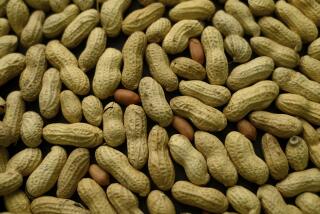For Those With Allergies, Noses Know It’s Bad
- Share via
The needle slid slowly into an inflated balloon and then out again--never bursting the balloon--as Dr. Joel E. Lewis demonstrated acupuncture to about 25 people gathered at a Newport Beach Central Library lecture to learn about allergies.
Lewis, who is director of the Allergy and Asthma Institute Medical Center of Southern California in Costa Mesa, said he combines acupuncture with modern medicine to treat allergies.
The audience listened intently this week as he confirmed what many already knew: This dry, windy fall has been unusually hard on allergy sufferers.
“I’m willing to try anything at this point,” Jean Fields, 64, of Laguna Hills said. “I have hay fever, sinus inflammations, coughing and fits where I can’t breathe.” Her stuffed-up-sounding voice illustrated the problem.
“At night,” she said, “I sleep on four pillows, and sometimes I have to sleep sitting up in a chair.”
While almost any time of year in Southern California is allergy season, allergy doctors say conditions have been harsher lately.
“It’s been a real severe allergy season this October--in particular hay fever seems to be worse than last year,” said Dr. Mark Sugar of Allergy and Asthma Associates of Southern California in Mission Viejo. Sugar also has a practice in Fountain Valley.
The Orange County Health Care Agency does not track the number of allergy sufferers, and information about the increase in sneezing and wheezing is mostly anecdotal as doctors report that they are seeing more patients and many allergy sufferers say their symptoms are worse.
What to do?
“Well, if you’re going outside, you’re going to be exposed to wind conditions, so then you really can’t avoid” the pollen, Sugar said. “It’s better to stay indoors and keep the windows closed.”
*
Better conditions, however, may be around the corner, said Dr. Richard Roth, an allergist at Kaiser Permanente Medical Center in Anaheim. The plants and trees responsible for some allergies are ending their pollination cycles, he said, and Santa Ana winds should be dying down.
“I think now we’re seeing the aftermath of the Santa Anas, and the Chinese elm tree season is ending, and sagebrush and tumbleweed pollinating are both ending,” Roth said. “Best thing to do now is just lie low.”
But for some, staying indoors has its perils too. Dust mites are as irritating to the sinuses for some people as pollen is for others.
“Unfortunately, dust is a problem you can never get completely away from,” Sugar said. The “dust mite is a living organism; it’s a parasite that lives off human skin scales that flake off during the course of the day and rubs off onto pillows and sheets at night.”
Careful cleaning of bedding and the home--vacuuming mattresses, carpets and upholstery--can help reduce the number of mites.
Most people inhaling the tiny particles of pollen and other allergens do so without notice. But for about 20% of the population, the particles release a protein causing an allergic reaction that restricts breathing. About 5% to 10% of the population suffers from asthma.
Joyce Loomis, 59, of Costa Mesa takes allergy shots for dust mites. She went to Lewis’ lecture to learn more about her allergies. Over the years, she has suffered from hay fever, sensitivity to some plant smells and pollution fumes, and eczema.
“The treatment for dust mites takes several months, and I’ve only been doing it for two months now, so it’s not working just yet,” Loomis said.
Both Fields and Loomis said allergies run in their families. Both had parents with severe allergies or asthma--a common occurrence for allergy sufferers, according to Lewis.
“Two major factors contribute to allergies: living in an environment where the air is filled with allergens, and a genetic predisposition,” he said.
“If one parent has allergies, the children have about a 30% chance of having allergies; if both do then it’s a 60% to 70% chance,” Lewis said.
During his lecture, Lewis urged eczema sufferers to keep their skin moisturized and to lower their intake of meat and dairy foods, which can exacerbate the condition. Dairy products, in particular, are often the cause of food-related allergies, and people may have a sensitivity they only discover once they have stopped eating them.
“I usually encourage my patients to have more of a vegetarian diet because people who rely more on plant sources of protein tend to have fewer problems,” Lewis said. “But it’s hard to have people make drastic changes in their eating habits--in particular when they’re not feeling well.”
Even constant vigilance does not always work.
Loomis, who said she uses an air filtering machine in her home and is mindful of detergents and fabrics that cause her eczema to flare up, had a red rash blooming on her arm by the end of Lewis’ speech that wasn’t there when he began.
After a minute or so she attributed it to a new fabric brightener she used on her cotton jacket.
“Oh well, that will have to go,” she sighed.
More to Read
Sign up for Essential California
The most important California stories and recommendations in your inbox every morning.
You may occasionally receive promotional content from the Los Angeles Times.










